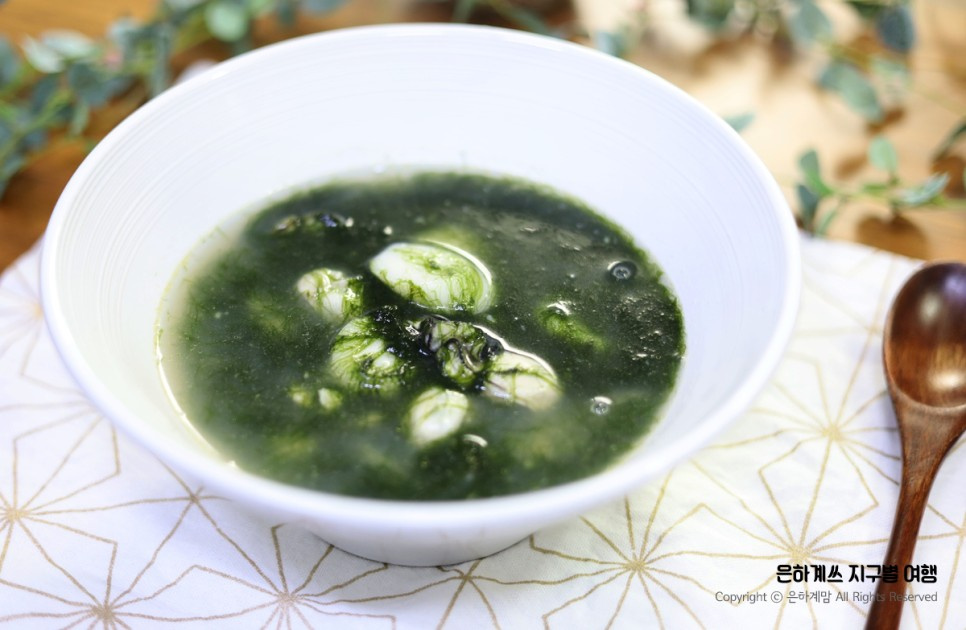Seaweed and Oyster Rice Cake Soup (Maesaeng-i Gul Tteokguk)
How to Make a Refreshing and Savory Maesaeng-i Gul Tteokguk

The Lunar New Year holiday is just around the corner. This year, gatherings are difficult due to the current situation, making the holiday feel less festive. To make up for it, I’ve prepared a special Tteokguk recipe filled with delicious food for a warm and joyful Seollal. While typically made with beef or anchovy broth, this version uses seasonal winter ingredients: fresh oysters and fragrant maesaeng-i (a type of green seaweed). The result is a truly refreshing ‘life-changing’ Tteokguk! My eldest son absolutely loves this dish. Let me guide you through making this wonderfully refreshing Maesaeng-i Gul Tteokguk, brimming with the scent of the sea and delicious oysters.
Main Ingredients (Serves 2)- Maesaeng-i (Korean green seaweed) 175g (approx. 1/2 bundle after thawing)
- Rice cake for soup (Tteokguk tteok) 1 handful (about 200g)
- Fresh oysters 1 packet (about 200-250g)
- Cheongju (rice wine) 1 Tbsp (to remove oyster odor)
- Minced garlic 1 Tbsp
- Soy sauce for soup (Guk-ganjang) 1 Tbsp (for seasoning)
- Flower salt (fine sea salt) 1 tsp (for seasoning)
- Sesame oil 1/2 Tbsp (for finishing aroma)
- Water 1 liter (for broth)
- Broth pack 1 (anchovies, kelp, etc.)
Cooking Instructions
Step 1
First, prepare the frozen maesaeng-i. It’s best to move it from the freezer to the refrigerator the night before to thaw slowly. Place the thawed maesaeng-i in a large bowl. Under running water, gently swirl it with your hands to rinse. Repeat this process 2-3 times, draining through a sieve, to ensure any tiny debris (like small twigs) is removed. Once clean, place the maesaeng-i in a sieve to drain excess water. (Tip: Frozen maesaeng-i can be stored for a long time, but once thawed and refrigerated, it’s best consumed within about a week.)

Step 2
Rice cakes for soup can be quite hard. Soak them in lukewarm water for about 10-15 minutes until they become soft and pliable. This step helps prevent the rice cakes from becoming mushy in the soup and maintains their chewy texture.

Step 3
Now, let’s make a delicious broth! In a pot, add 1 liter of clean water and the broth pack (containing anchovies, kelp, etc.). Bring it to a boil over high heat. Once it’s vigorously boiling, reduce the heat to medium and simmer for another 7 minutes to extract a deep flavor. After the broth has steeped, remove and discard the broth pack.

Step 4
It’s important to clean fresh oysters thoroughly. Place the oysters in a bowl and add about 1 teaspoon of fine sea salt. Gently massage them with your hands. This process helps to remove any slimy residue or impurities from the oyster surface. Afterward, lightly rinse them under cold running water and drain them well in a sieve. Be careful not to over-wash the oysters, as this can diminish their flavor.

Step 5
In a pot preheated over medium heat, add the drained maesaeng-i and ‘stir-fry’ it briefly without oil. Once the maesaeng-i starts to cook slightly, add 1 tablespoon of Cheongju (rice wine) and continue to stir-fry for about 1 more minute. Adding Cheongju effectively removes any fishy odor from the maesaeng-i, resulting in a cleaner taste. (Tip: If you don’t have Cheongju, you can substitute it with Mirin. Also, there’s no need to cut the maesaeng-i; it will naturally break into bite-sized pieces as it cooks.)

Step 6
Pour the well-brewed anchovy-kelp broth over the stir-fried maesaeng-i and bring it back to a boil over high heat. Once the soup begins to boil, adjust the heat accordingly.

Step 7
Add the softened rice cakes for soup to the pot. Season with 1 tablespoon of soup soy sauce (Guk-ganjang) and 1 teaspoon of fine sea salt. Using soup soy sauce first for the base flavor and then adjusting with salt allows for a balanced and savory taste.

Step 8
Now, add 1 tablespoon of minced garlic. The garlic’s aroma will enrich the overall flavor of the Tteokguk.

Step 9
Check if the rice cakes are tender. Once they are cooked, add the prepared fresh oysters. Oysters can become tough if overcooked, so simmer for just a short while longer to enjoy their tender and plump texture. Be mindful not to boil vigorously or for too long after adding the oysters.

Step 10
Finally, drizzle in 1/2 tablespoon of sesame oil for an added nutty aroma and enhanced flavor. This completes the preparation of your special Maesaeng-i Gul Tteokguk, which is savory, refreshing, and full of the sea’s essence! Enjoy a warm bowl and have a wonderful holiday.



